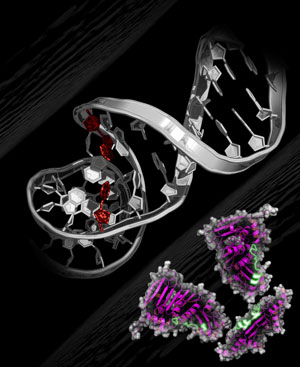Mar. 23, 2012 Research Highlight Biology
Mismatch repair protein meets its match
Mutations in people with cancerous Lynch syndrome prevent a DNA mismatch repair protein from doing its job properly
 Figure 1: An image of a mismatched DNA duplex (left) with the MutL protein (right). Binding of ATP by MutL induces a structural change around the interdomain-interacting regions (shown in green) that regulate the protein's activity. © 2012 Hitoshi Iino
Figure 1: An image of a mismatched DNA duplex (left) with the MutL protein (right). Binding of ATP by MutL induces a structural change around the interdomain-interacting regions (shown in green) that regulate the protein's activity. © 2012 Hitoshi Iino
When the cell’s DNA proofreading system encounters a mismatch in the genome, a number of repair proteins are thrown into action, ripping up the mistake and filling in the correct nucleotides. One of these proteins, an endonuclease called MutL in bacteria, nicks the error-containing strand of DNA with the help of ATP, the energy currency of the cell. However, the exact mechanism by which ATP regulates the DNA-cutting enzyme has eluded biochemists.
Now, a research team from Japan has shown that ATP physically binds the repair protein1, causing a structural rearrangement at the enzyme’s catalytic site that triggers the genetic slicing and dicing.
Led by Kenji Fukui from the RIKEN SPring-8 Center in Harima, the researchers performed a series of structural imaging experiments in the heat-loving bacterium Aquifex aeolicus to tease apart how ATP affects MutL (Fig. 1). Using a mass spectrometry technique designed for monitoring conformational changes in proteins, they showed that ATP first binds to one end of the MutL protein. Through a series of physical interactions, this binding then induces structural changes at the opposite end of the protein—where the catalytic site is located—spurring the enzyme into action.
Importantly, the study revealed two novel, highly conserved regions of MutL—one in the ATP-binding region, another in the catalytic region—that are essential for the protein’s DNA cleaving activity. “We were surprised because the newly identified catalytic region had not been thought to be involved in the catalysis of endonucleolytic reaction,” says Fukui.
In the human equivalent of MutL, mutations in this catalytic region are known to cause Lynch syndrome, a heritable form of cancer marked by a faulty DNA mismatch repair system. Consistent with this observation, Fukui and colleagues studied MutL with mutations at the catalytic region and saw a decrease in enzymatic activity. As such, the team’s study could provide a molecular explanation for the repair defect seen in people with that disease. “Dysfunction of MutL endonuclease activity [seems to] be one of the major causes for Lynch syndrome,” Fukui notes.
More fine-scale structures are still needed, however, to fully characterize the ATP-dependent structural rearrangement of the protein in both healthy and mutated forms of MutL. To that end, Fukui is now further probing the protein using x-ray crystallography and other methods. “The precise biochemical characterization of A. aeolicus’s MutL will accelerate the cellular biological studies on human MutL homolog,” Fukui says.
References
- 1. Yamamoto, T., Iino, H., Kim, K., Kuramitsu, S. & Fukui, K. Evidence for ATP-dependent structural rearrangement of nuclease catalytic site in DNA mismatch repair endonuclease MutL. Journal of Biological Chemistry 286, 42337–42348 (2011). doi: 10.1074/jbc.M111.277335
